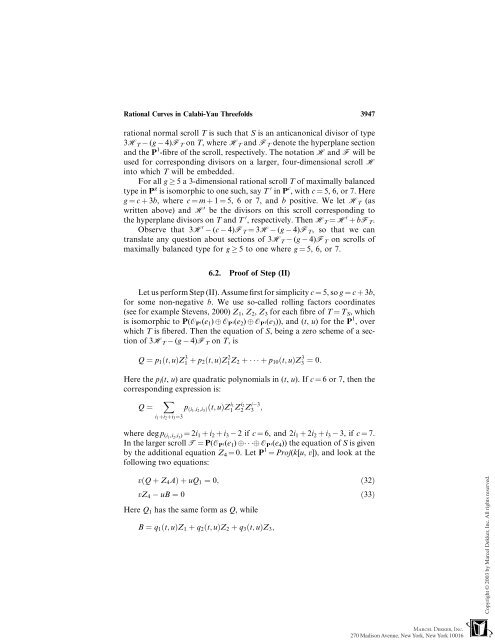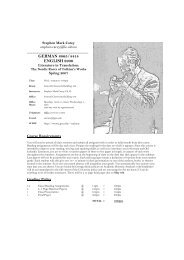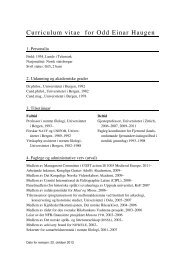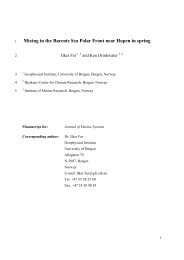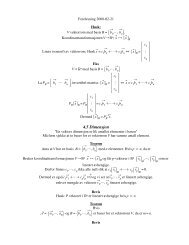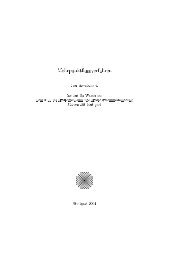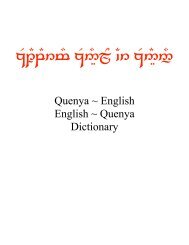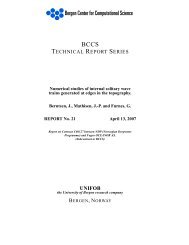Rational Curves in Calabi-Yau Threefolds
Rational Curves in Calabi-Yau Threefolds
Rational Curves in Calabi-Yau Threefolds
You also want an ePaper? Increase the reach of your titles
YUMPU automatically turns print PDFs into web optimized ePapers that Google loves.
<strong>Rational</strong> <strong>Curves</strong> <strong>in</strong> <strong>Calabi</strong>-<strong>Yau</strong> <strong>Threefolds</strong> 3947<br />
rational normal scroll T is such that S is an anticanonical divisor of type<br />
3HT (g 4)FT on T, where HT and FT denote the hyperplane section<br />
and the P 1 -fibre of the scroll, respectively. The notation H and F will be<br />
used for correspond<strong>in</strong>g divisors on a larger, four-dimensional scroll H<br />
<strong>in</strong>to which T will be embedded.<br />
For all g 5 a 3-dimensional rational scroll T of maximally balanced<br />
type <strong>in</strong> P g is isomorphic to one such, say T 0 <strong>in</strong> P c , with c ¼ 5, 6, or 7. Here<br />
g ¼ c þ 3b, where c ¼ m þ 1 ¼ 5, 6 or 7, and b positive. We let HT (as<br />
written above) and H 0 be the divisors on this scroll correspond<strong>in</strong>g to<br />
the hyperplane divisors on T and T 0 , respectively. Then HT ¼ H 0 þ bFT.<br />
Observe that 3H 0 (c 4)FT ¼ 3H (g 4)FT, so that we can<br />
translate any question about sections of 3H T (g 4)F T on scrolls of<br />
maximally balanced type for g 5 to one where g ¼ 5, 6, or 7.<br />
6.2. Proof of Step (II)<br />
Let us perform Step (II). Assume first for simplicity c ¼ 5, so g ¼ c þ 3b,<br />
for some non-negative b. We use so-called roll<strong>in</strong>g factors coord<strong>in</strong>ates<br />
(see for example Stevens, 2000) Z1, Z2, Z3 for each fibre of T ¼ TS, which<br />
is isomorphic to P(OP 1(e1) OP 1(e2) OP 1(e3)), and (t, u) for the P 1 , over<br />
which T is fibered. Then the equation of S, be<strong>in</strong>g a zero scheme of a section<br />
of 3HT (g 4)FT on T, is<br />
Q ¼ p1ðt; uÞZ 3 1 þ p2ðt; uÞZ 2 1Z2 þ þp10ðt; uÞZ 3 3 ¼ 0:<br />
Here the pi(t, u) are quadratic polynomials <strong>in</strong> (t, u). If c ¼ 6 or 7, then the<br />
correspond<strong>in</strong>g expression is:<br />
Q ¼ X<br />
i1þi2þi3¼3<br />
p ði1;i2;i3Þðt; uÞZ i1<br />
1 Zi2<br />
3<br />
2<br />
Zi 3 ;<br />
where deg p(i 1,i 2,i 3) ¼ 2i1 þ i2 þ i3 2ifc ¼ 6, and 2i1 þ 2i2 þ i3 3, if c ¼ 7.<br />
In the larger scroll T ¼ P(O P 1(e 1) O P 1(e 4)) the equation of S is given<br />
by the additional equation Z 4 ¼ 0. Let P 1 ¼ Proj(k[u, v]), and look at the<br />
follow<strong>in</strong>g two equations:<br />
vðQ þ Z4AÞþuQ1 ¼ 0; ð32Þ<br />
vZ4 uB ¼ 0 ð33Þ<br />
Here Q1 has the same form as Q, while<br />
B ¼ q1ðt; uÞZ1 þ q2ðt; uÞZ2 þ q3ðt; uÞZ3;


